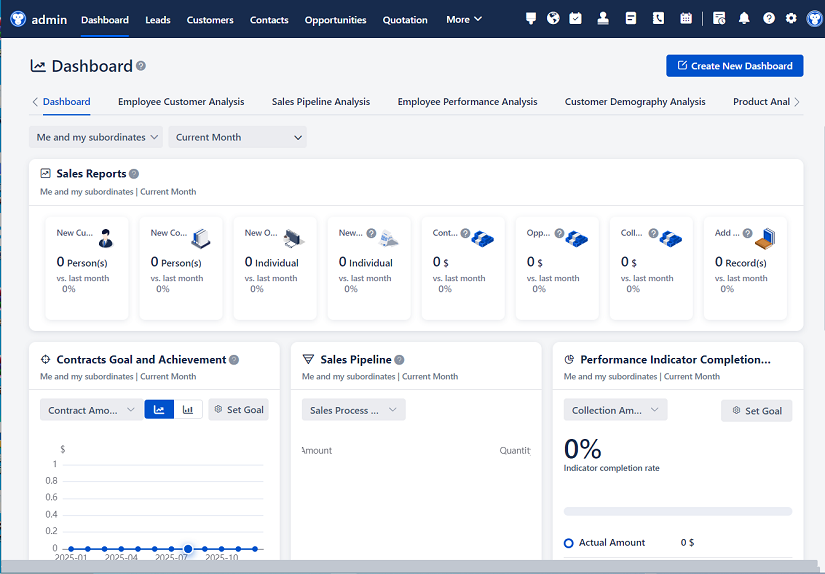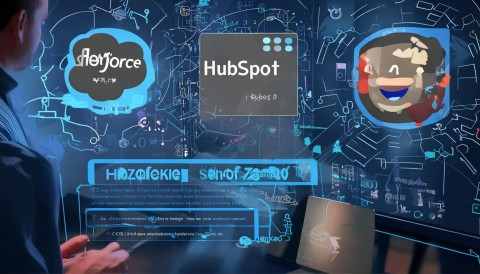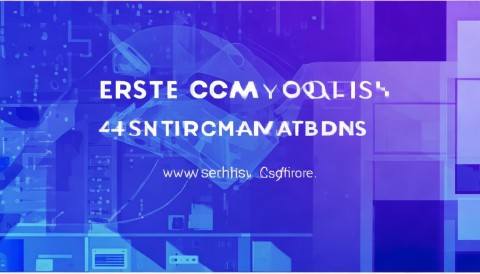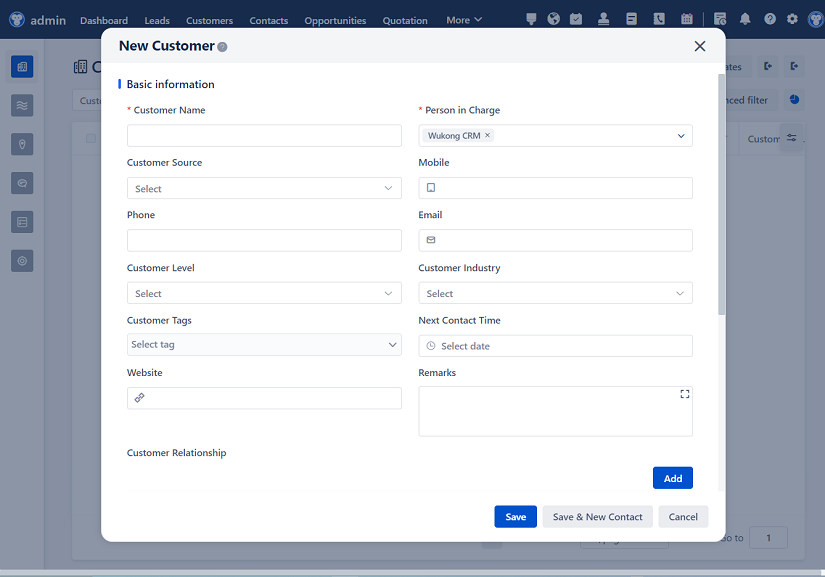
△Click on the top right corner to try Wukong CRM for free
So, you know how businesses these days are all about building better relationships with their customers? Yeah, I mean, it’s not just about selling something and moving on. It’s about keeping people happy, understanding what they need, and making them feel valued. That’s where CRM systems come in—Customer Relationship Management tools. They’re like the digital backbone for managing all those customer interactions. But here’s the thing: not every business is the same. A small online store has different needs than a multinational corporation with sales teams across continents. So, one-size-fits-all doesn’t really work when it comes to CRM.
That’s why customization functions and configuration methods are so important. Honestly, if your CRM can’t adapt to how your team actually works, it’s kind of useless. I’ve seen companies waste thousands on fancy software that ends up sitting there unused because it didn’t fit their workflow. And that’s exactly what we’re going to talk about today—how you can tweak and shape a CRM system to match your unique business processes.
Free use of CRM system: Free CRM
Let me start by saying this: customization and configuration aren’t the same thing, even though people often use them interchangeably. Configuration is usually about adjusting settings within the existing framework of the CRM. Think of it like setting up your phone—you don’t rewrite the operating system, but you change the wallpaper, notifications, app layout, etc. With CRM, that could mean adding new fields to a contact form, changing the stages in your sales pipeline, or setting up automated email responses.
Customization, on the other hand, goes deeper. It’s more like modifying the actual structure or behavior of the system. Maybe you want to create a completely new module for tracking customer feedback, or integrate a third-party analytics tool that wasn’t originally supported. That’s customization—it requires more technical skill, sometimes coding, and a clearer understanding of what you’re trying to achieve.
Now, most modern CRM platforms—like Salesforce, HubSpot, Zoho, or Microsoft Dynamics—come with some level of built-in configurability. You don’t need to be a developer to make basic changes. For example, you can usually drag and drop fields into forms, set up workflows using visual builders, or assign roles and permissions through a user-friendly admin panel. These tools are designed so that even non-tech-savvy managers can adjust things without breaking anything.

But let’s say your sales team follows a very specific process—maybe they qualify leads based on industry, company size, and budget before moving them to the next stage. The default pipeline in your CRM might not reflect that. So what do you do? You configure it. You go into the settings, rename the stages, add custom fields, and maybe even set up rules that automatically move a lead forward when certain criteria are met. It’s like teaching the system to think the way your team thinks.
And honestly, that’s where the real value kicks in. When your CRM mirrors your actual business logic, your team is more likely to use it consistently. No more spreadsheets floating around or notes in random notebooks. Everything lives in one place, updated in real time.
But here’s a tip: don’t overdo it. I’ve seen teams get so excited about customization that they end up with a bloated, confusing system. Too many fields, too many automation rules, too many dashboards. It becomes overwhelming. So, keep it simple. Start with the core processes—sales, marketing, support—and build from there. Ask yourself: “What information do we absolutely need?” and “How can this help us serve customers better?”
Another big part of configuration is user roles and access control. Not everyone in your company should see everything. Your customer service rep doesn’t need access to financial forecasts, and your intern shouldn’t be able to delete client records. Most CRMs let you define roles—like admin, manager, agent—and assign specific permissions. You can even restrict access by region or department. It’s not just about security; it’s about relevance. People stay focused when they only see what matters to their job.
Now, let’s talk integrations. This is where customization really shines. Your CRM probably doesn’t exist in a vacuum. You’ve got email, calendars, social media, e-commerce platforms, maybe even accounting software. If your CRM can’t talk to those tools, you’re stuck copying and pasting data all day. Nobody wants that.
So, customization often involves connecting your CRM to other systems. Many platforms offer pre-built connectors—like syncing Gmail contacts or pulling Shopify orders into customer profiles. But sometimes, you need something more unique. Maybe you have a legacy inventory system that doesn’t play nice with standard APIs. In that case, you might need custom scripts or middleware to bridge the gap.
And yes, that does require some technical know-how. But don’t panic. A lot of CRM vendors now offer low-code or no-code solutions. Tools like Zapier or Make (formerly Integromat) let you create automated workflows between apps without writing a single line of code. For example, you can set it up so that when someone fills out a web form, their info automatically gets added to your CRM, tagged as a lead, and assigned to a salesperson—all without manual intervention.
But let’s be real: not every customization should be done by non-developers. Some changes affect performance or data integrity. Imagine accidentally creating a loop where an automated email triggers itself over and over. Or worse—deleting critical data because a script ran incorrectly. That’s why it’s smart to test any major changes in a sandbox environment first. Most enterprise CRMs offer a testing instance where you can play around without risking your live data.
Another thing people forget is mobile access. A lot of customer interactions happen on the go—sales reps visiting clients, support agents answering calls from home, managers checking reports during commutes. So, your CRM should work well on phones and tablets. Good news: most modern systems have responsive designs or dedicated mobile apps. But you might still need to customize the mobile interface—hide less-used fields, prioritize key actions, optimize loading times. Because nobody’s going to use a clunky app that takes forever to load.
Reporting and dashboards are another area where customization makes a huge difference. Out-of-the-box reports are fine, but they often don’t answer the questions your team actually cares about. What’s our conversion rate by region? How long does it take support to resolve tickets? Which marketing campaigns bring in the highest lifetime value customers?
You can usually build custom reports using filters, groupings, and calculated fields. Some CRMs even let you create dynamic dashboards that update in real time. And if you’re really advanced, you can pull CRM data into external BI tools like Power BI or Tableau for deeper analysis. That’s customization at its best—turning raw data into actionable insights.
Oh, and don’t forget about branding. Yeah, I know—it sounds superficial, but hear me out. If your CRM looks like your company—same colors, logo, terminology—it feels more familiar to your team. It’s not just some generic software; it’s your system. Plus, if you share dashboards or reports with clients or partners, a branded interface looks more professional.
Now, how do you actually go about implementing all this? Well, it depends on your CRM platform. Some are more flexible than others. Salesforce, for example, is incredibly powerful but has a steeper learning curve. HubSpot is more user-friendly but might not handle complex workflows as well. Zoho offers a good middle ground with lots of modules you can turn on or off.

The process usually starts with discovery. Sit down with your team and map out your current processes. Where do bottlenecks happen? What information is missing? What tasks are repetitive and could be automated? Once you know what you need, you can decide what to configure versus what requires deeper customization.
Then comes the setup phase. This is where you tweak settings, create custom fields, design workflows, and connect integrations. It’s tempting to rush this part, but trust me—take your time. Get input from actual users. Run pilot tests. Make adjustments. It’s way easier to fix things early than after everyone’s trained and reliant on the system.
Training is another crucial step. No matter how perfectly configured your CRM is, it won’t help if people don’t know how to use it. So, run workshops, create quick-reference guides, maybe even assign internal champions who can help others. And keep the feedback loop open. After a few weeks, ask your team: “What’s working? What’s frustrating? What’s missing?” Then go back and refine.
One last thing—maintenance. Customized systems need ongoing care. Software updates can break integrations. Business needs evolve. New team members join. So, schedule regular reviews. Clean up old data. Retire unused features. Keep documentation updated. Think of your CRM like a car: it runs great when maintained, but neglect it, and it’ll eventually stall.
Alright, let’s wrap this up. Customization and configuration aren’t just technical checkboxes—they’re strategic tools. When done right, they turn your CRM from a passive database into an active partner in growing your business. It’s not about making the system more complex; it’s about making it more relevant. More helpful. More human.
Because at the end of the day, CRM isn’t really about technology. It’s about people—your customers, your team, your relationships. And if your system helps strengthen those connections, then you’ve nailed it.
FAQs (Frequently Asked Questions):
Q: Can I customize my CRM without knowing how to code?
A: Absolutely! Many CRM platforms offer drag-and-drop builders, pre-built templates, and no-code automation tools. You can handle a lot of customization—like adding fields, creating workflows, or setting up reports—without touching a single line of code.
Q: What’s the difference between configuration and customization again?
A: Great question. Configuration means adjusting settings within the existing system—like changing labels, setting up rules, or managing user roles. Customization goes further, like building new features, integrating external tools, or modifying the system’s behavior, which may require coding.
Q: How do I know if my CRM needs customization?
A: If your team is using workarounds—like spreadsheets, sticky notes, or duplicate entries—your CRM probably isn’t aligned with your workflow. Also, if reporting feels incomplete or automation isn’t saving time, it might be time to customize.
Q: Will customizing my CRM slow it down?
A: It can, if you go overboard. Too many custom fields, complex automations, or poorly optimized integrations might affect performance. Always test changes and monitor system speed after updates.

Q: Can I undo a customization if it doesn’t work?
A: Usually, yes—especially if you tested it in a sandbox first. Most CRMs allow you to roll back changes, disable workflows, or restore backups. Just make sure you have a backup strategy in place.
Q: Are there risks in customizing a CRM?
A: Sure. Risks include data loss, integration failures, or user confusion. That’s why it’s smart to plan carefully, test thoroughly, and involve stakeholders before rolling out big changes.
Q: How often should I review my CRM setup?
A: At least twice a year. Businesses change, teams grow, and goals shift. Regular check-ins help ensure your CRM continues to support your evolving needs.
Q: Do all CRM systems support deep customization?
A: No. Simpler CRMs (like Insightly or Pipedrive) focus on ease of use and may limit advanced customization. Enterprise systems (like Salesforce or Dynamics 365) offer much deeper flexibility—but come with higher complexity and cost.

Related links:
Free trial of CRM
Understand CRM software

△Click on the top right corner to try Wukong CRM for free